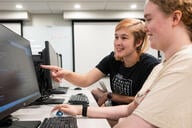You have /5 articles left.
Sign up for a free account or log in.

Students use sticky notes to offer feedback to faculty members in a classroom brainstorm exercise.
iStock /Getty Images Plus / Rawpixel
Faculty members and assessment office staff at Macalester College in Minnesota solicited student feedback on building community in the classroom through a collaborative brainstorm activity early in the term. Instructors used students’ suggestions to enhance the course design and class behaviors and promote belonging and connection.
What’s the need: Students have opportunities to engage with their peers and create community in residential, social and co-curricular settings but less often have this opportunity in their academics, biology professor Devavani Chatterjea explains.
This has been true for years, but with students returning to in-person learning and residential campus life after the pandemic, Chatterjea had a renewed interest in creating connections in the classroom.
What it is: Chatterjea and her colleagues Nancy Bostrom, associate director of assessment, and Bethany Miller, director of institutional research and assessment, launched the Classroom Community and Connectedness Project at Macalester in September 2021.
Professors at the college could elect to participate, allocating 45 to 60 minutes of one of their classes during the first three weeks of the term to a brainstorming session led by the project team. During the 2021–22 academic year, 20 faculty members opted in, and the team visited 30 courses, ranging from biology and geography to philosophy, gender studies and political science.
During a brainstorming session, students get pads of sticky notes and respond to the following questions, writing each thought on a separate note:
- What is working well to support community and connectedness in this class?
- What are the barriers to community and connectedness in this class?
- What can students do to strengthen a sense of community?
- What can the instructor do to strengthen the classroom community?
The brainstorm leaders (Chatterjea, Bostrom and Miller) would place four poster boards around the classroom, corresponding to the questions. After writing down a short response, students place their anonymous answers on the boards.
“Most students contributed five to 10 ideas for each question. ... So a class of 20 students would have 100 to 200 ideas to analyze for a single question, which is the power of the process,” says Chatterjea.
Students are divided into four teams to reflect on and analyze one of the questions and responses to establish the major themes represented. Each team identifies the themes on the poster board and verbally shares them with the class.
Following the analysis, students take a “gallery walk” around the classroom, equipped with a blue dot to stick on the poster board so they can identify priorities among the themes presented.
After the in-class exercise, the project team debriefs with the professor to share the themes and priorities established by their students. All classroom responses are gathered into a meta-analysis, as well.
What’s the impact: Through the meta-analysis, four key themes emerged in creating community and connectedness in the classroom:
- Interpersonal relationships. Activities like learning students’ names, well-being check-ins, encouraging asking questions and welcoming all kinds of ideas foster a sense of social and academic belonging.
- Collaboration. Students want authentic collaboration like classroom discussions, group projects and small groups that facilitate subject-matter conversations and social ones.
- Instructional design. Case studies or connecting the curriculum to current events increases student connection and community. Additionally, students enjoy courses with Slack channels or social media to connect with their peers.
- Use of physical space. Students prefer seating arrangements and work spaces that promote interaction and collaboration.
Survey says: Over all, follow-up indicated that professors received helpful suggestions from their students on how to create community and implemented them accordingly. In 2021, 90 percent of faculty participants implemented changes to their classroom model, and in fall 2022, 100 percent of professors made changes.
Of the surveyed student participants from fall 2021, 90 percent agreed that it is important to be intentional in building community in courses at the college, and 70 percent felt the brainstorming activity and the subsequent ideas created a sense of community.
“In more than one class, the activity itself was the first communal, collaborative project they had undertaken,” Chatterjea says.
In fall 2022, student survey questions targeted the inclusivity of the activity, and Chatterjea’s team found that around 90 percent of students felt welcomed and included in the activity and that their ideas were accounted during the analysis.
Moving forward: From fall 2021 to 2022, the project activity has remained the same. Looking ahead, the Classroom Community and Connectedness Project will become a faculty-paired activity in which instructors take turns facilitating the brainstorming activity in one another’s classes.
Editor's Note: This story was updated to clarify and provide more detail on how students respond to the brainstorming questions.
If your student success program has a unique feature or twist that you believe is worth modeling, we’d like to know about it. Click here to submit.




